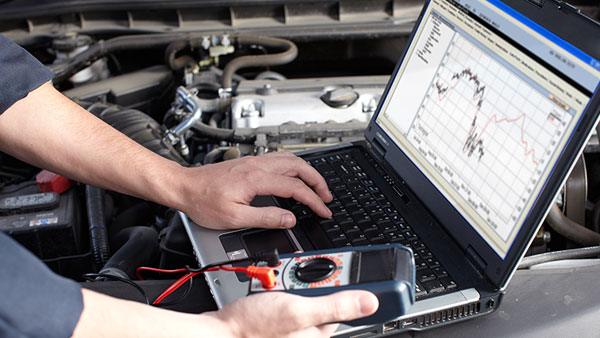AUTO REPAIRS – Engine Diagnostics
We have the expertise needed to solve all engine issues
YOUR VEHICLE’S ENGINE AND ITS FUEL INJECTION SYSTEM
The purpose of the fuel injection system is to calibrate and optimize the fuel/air ratio that enters your vehicle’s engine. It is made up of electronic components and sensors. Fuel injection has recently become the primary fuel delivery system used in gasoline-powered automobiles, almost completely replacing carburetors.

SIGNS OF POTENTIAL ISSUES RELATED TO THE FUEL INJECTION SYSTEM
- Fuel smell
- Engine has low power
- Engine cranks but doesn’t start
- The “Check Engine” warning light is on in the dashboard
- The “Oil” warning light is on in the dashboard
Have you noticed one or more of these issues on your vehicle? Book an appointment with our experts now.
THE “CHECK ENGINE” WARNING LIGHT
The engine light is part of the on-board computer’s diagnostic system. The computer controls and monitors your vehicle’s performance while its various components regulate variables such as engine speed, fuel mixture and ignition timing.
When it detects a problem in the electronic control system that it cannot correct, the computer issues a warning through the “Check Engine” yellow light. In addition to this light, the computer records a breakdown code in its memory that identifies the source of the problem, such as a defective sensor or the engine that didn’t ignite.
This code can be read with an electronic analysis tool or a diagnostic computer, which is standard equipment at our auto repair garage. Do-it-yourselfers can also use one of many inexpensive code readers that are designed with them in mind. However, a diagnostic computer such as ours provides much more than a simple error code: it also allows us to analyze several of your engine’s sensors in real time. This saves us a significant amount of diagnostic time, which we pass on as savings to our clients!
Keep in mind that a code will simply give you the source of the problem. You’ll still need an experienced professional to diagnose and repair the issue.
THE “OIL” WARNING LIGHT
This light is also on the dashboard and comes on when either the oil pressure or oil level is too low. This is a serious situation: DO NOT CONTINUE DRIVING. It could lead to burning out the engine.
Low oil pressure can result from a failed oil pump or from a blocked oil filter or strainer; it can also be due to the engine burning oil. A low oil level, for its part, is most probably due to a leak in the lubrication system. In any case, you must see to it quickly!
LEARN MORE ABOUT THE FUEL INJECTION SYSTEM
THE MAIN COMPONENTS OF THE FUEL INJECTION SYSTEM
- Sensors
- Electronic control unit (ECU)
- “Check Engine” or “Service Engine Soon” engine lights
- Fuel injectors
- Fuel pump
HOW DOES THE FUEL INJECTION SYSTEM WORK?
The fuel injection system consists of several sensors located throughout your vehicle. Every time you start your vehicle, the Electronic Control Unit (ECU) scans all these sensors to verify their functionality. The “Check Engine” light on the dashboard comes on during this scan and goes off when all sensors are functional.
While you are driving, these sensors continuously detect the values of numerous parameters:
- Air pressure
- Air temperature
- Throttle angle
- Air density
- Fuel temperature
- Fuel pressure
- Oil pressure
- Coolant temperature
- Exhaust temperature
- Crankshaft angle
- Timing
- Engine RPM
- Speed
These data are processed through the ECU to set the fuel injectors’ optimal opening time as they inject fuel into your engine’s intake ports. The fuel injectors are usually only open for a few milliseconds at a time.
Each fuel injector includes a nozzle and a valve. Injection power comes from a fuel pump located farther back in the fuel delivery system. The fuel going through the system is atomized by being forcibly pumped through a small nozzle under high pressure.
LEARN MORE ABOUT THE FUEL INJECTION SYSTEM
THE MAIN COMPONENTS OF THE FUEL INJECTION SYSTEM
- Sensors
- Electronic control unit (ECU)
- “Check Engine” or “Service Engine Soon” engine lights
- Fuel injectors
- Fuel pump

HOW DOES THE FUEL INJECTION SYSTEM WORK?
The fuel injection system consists of several sensors located throughout your vehicle. Every time you start your vehicle, the Electronic Control Unit (ECU) scans all these sensors to verify their functionality. The “Check Engine” light on the dashboard comes on during this scan and goes off when all sensors are functional.
While you are driving, these sensors continuously detect the values of numerous parameters:
- Air pressure
- Air temperature
- Throttle angle
- Air density
- Fuel temperature
- Fuel pressure
- Oil pressure
- Coolant temperature
- Exhaust temperature
- Crankshaft angle
- Timing
- Engine RPM
- Speed
These data are processed through the ECU to set the fuel injectors’ optimal opening time as they inject fuel into your engine’s intake ports. The fuel injectors are usually only open for a few milliseconds at a time.
Each fuel injector includes a nozzle and a valve. Injection power comes from a fuel pump located farther back in the fuel delivery system. The fuel going through the system is atomized by being forcibly pumped through a small nozzle under high pressure.
The fuel injection system must be kept clean and properly calibrated to maximize the engine’s power and efficiency, and also to decrease fuel consumption.
At Autotech Performance, our technicians can assure you that you vehicle’s engine and its fuel injection system are as efficient as ever!



